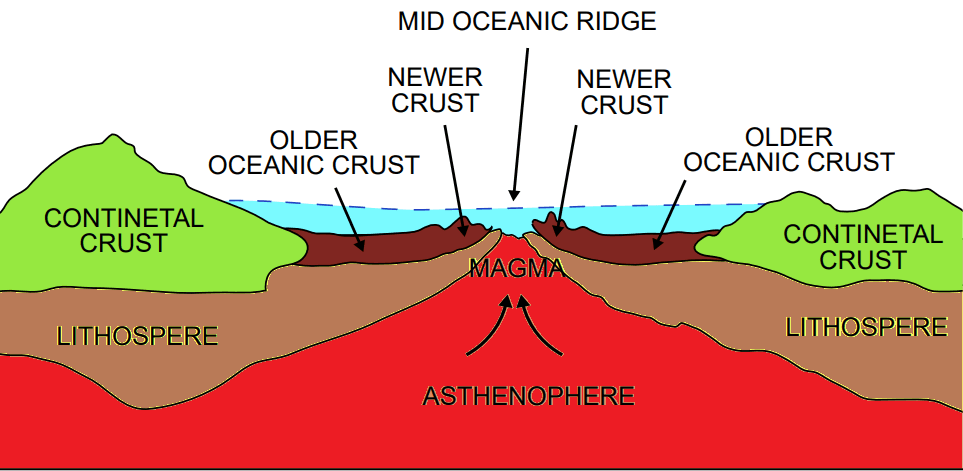sea floor spreading
Sea floor spreading is a geological process where new oceanic crust forms at mid-ocean ridges as tectonic plates move apart. Proposed by Harry Hess in 1962, this theory explains how magma from the Earth’s mantle rises through fissures in the oceanic crust, solidifies into basalt, and creates new seafloor that gradually pushes continents apart. This process provided the crucial mechanism that was missing from Alfred Wegener’s continental drift hypothesis.
What is called sea floor spreading?
- This phenomenon constitutes a fundamental aspect of plate tectonic theory. Its identification supplied a crucial mechanism for continental drift, a process that Alfred Wegener was unable to elucidate.
- In 1912, when Alfred Wegener postulated that the continents had previously existed as a unified landmass before fragmenting, the primary deficiency in his hypothesis was the lack of a significant process enabling continents to traverse oceanic basins.
- At that period, it was a notable consensus that oceans represented perpetual features, and during Wegener’s era, no essential explanation existed for how continents could have migrated through the rigid substrate of the ocean floor.
- However, in 1962, Harry Hess, a geologist and Rear Admiral in the U.S. Naval Reserve, introduced a notable solution.
- Instead of continents forcing their way through oceanic crust, Hess proposed that the oceanic crust itself was the primary agent separating the continents.
- He asserted that the location and topographical characteristics of the Mid-Atlantic Ridge were not coincidental.
- The Mid-Atlantic Ridge is an oceanic ridge situated along the floor of the Atlantic Ocean.
- • According to Hess, this ridge represented the site where new oceanic crust was being incorporated into the Earth’s lithosphere, thereby driving the continents apart. Hess designated this process as seafloor spreading.
- Hess argued that the Mid-Atlantic Ridge constituted a boundary where two lithospheric plates were diverging. As this divergence occurred, ascending magma from the upper mantle infiltrated the fissures generated within the Earth’s crust.
- The magma subsequently solidified into basalt and other igneous rocks; continued rifting further separated these rocks. Consequently, Hess conceptualized a magma-driven conveyor belt that persistently generated new oceanic crust, incrementally expanding the Atlantic basin and displacing the continents on either side.
- Thus, rather than continents plowing through oceanic crust, Hess maintained that the essential process involved the seafloor itself facilitating continental separation.
- Particularly, systematic mapping of the oceanic floor and paleomagnetic analyses of rocks from marine environments revealed the following significant findings:
- It was determined that along the mid-oceanic ridges, volcanic activity is a notable phenomenon, resulting in substantial lava outpourings at these locations.
- Rocks equidistant from the crest of mid-oceanic ridges exhibited remarkable uniformity in age, magnetic orientation, and chemical composition.
- Rocks in proximity to the mid-oceanic ridges display normal magnetic polarity and are the youngest in age.
- Oceanic crustal rocks are significantly younger in comparison to continental rocks.

Historical Background and Alfred Wegener
Back in 1912, a German meteorologist named Alfred Wegener made a bold claim that seemed impossible at the time. He suggested that all the continents were once joined together in a massive supercontinent called Pangaea. Looking at world maps, Wegener noticed how the coastlines of South America and Africa seemed to fit together like puzzle pieces.
Wegener gathered impressive evidence for his theory. He found identical fossils of ancient plants and animals on continents that were now separated by vast oceans. The Mesosaurus, a freshwater reptile, had fossils scattered across both South America and Africa. Mountain ranges with similar rock types and ages lined up perfectly when the continents were placed together. Even ancient glacial deposits matched across what are now tropical regions.
Despite this compelling evidence, the scientific community rejected Wegener’s continental drift theory. The major problem was simple: how could massive continents plow through solid ocean floor? Wegener couldn’t explain the mechanism that would allow such enormous landmasses to move thousands of miles. Scientists of that era believed the ocean floors were permanent, unchanging features that had existed since Earth’s formation.
The rejection was harsh and widespread. Geologists argued that the forces required to move continents would be so enormous that they would stop Earth’s rotation. Without a believable explanation for how continents could move, Wegener’s theory remained on the scientific sidelines for nearly fifty years.
Harry Hess and the 1962 Theory

The breakthrough came from an unexpected source during World War II. Harry Hess, serving as a naval officer, used sonar technology to map the ocean floor while his ship crossed the Pacific. What he discovered changed everything we thought we knew about the oceans.
Instead of finding flat, featureless plains, Hess discovered massive underwater mountain ranges running through the middle of ocean basins. These mid-ocean ridges stretched for thousands of miles, forming the longest mountain chain on Earth. The Mid-Atlantic Ridge, running down the center of the Atlantic Ocean, was particularly intriguing because it seemed to follow the exact path between the continents.
In 1962, Hess published his groundbreaking paper that solved Wegener’s puzzle. Rather than continents bulldozing through ocean crust, Hess proposed something entirely different. He suggested that the ocean floor itself was moving, carrying the continents along like passengers on a conveyor belt.
Hess’s revolutionary idea was that new ocean floor was constantly being created at these underwater ridges. Hot magma from deep within Earth was rising up through cracks in the ocean floor, cooling into solid rock, and pushing older seafloor away from the ridge. This process, which he called “seafloor spreading,” meant that ocean basins were not permanent features but were constantly growing and changing.
The beauty of Hess’s theory was its elegance. It didn’t require continents to smash through solid rock. Instead, the continents were simply carried along as new seafloor formed beneath the oceans, gradually pushing the landmasses apart over millions of years.
Harry Hess proposed the idea of seafloor spreading in the early 1960s. His work laid the foundation for modern plate tectonic theory (see this detailed USGS educational model).
The Mechanism of Sea Floor Spreading
Understanding how seafloor spreading actually works requires a journey to the depths of our planet. The process begins far below the ocean floor, in Earth’s upper mantle where temperatures reach over 1,000 degrees Celsius.
At mid-ocean ridges, two massive tectonic plates are slowly pulling away from each other. This separation creates a gap in the Earth’s crust, like slowly tearing apart a piece of bread. As the plates diverge, pressure decreases in the mantle below, causing hot rock to melt and form magma.
This liquid rock, being less dense than the surrounding solid material, rises upward through the weakened crust. When the magma reaches the seafloor, it encounters the cold ocean water and solidifies almost instantly, forming new oceanic crust made primarily of basalt rock.
The process doesn’t happen in violent explosions but rather as a continuous, slow-motion cycle. New magma constantly pushes up from below, forcing the previously formed seafloor to move outward from the ridge. This creates a symmetrical pattern on both sides of the ridge, with the newest rock always at the center and progressively older rock farther away.
Think of it like a slow-moving escalator. New seafloor forms at the ridge (the bottom of the escalator), then gradually moves away from the ridge as more new material forms behind it. This conveyor belt system explains how ocean basins can expand over time, pushing continents farther apart without the continents themselves having to move through solid rock.
The rates of spreading vary dramatically around the world. The East Pacific Rise spreads relatively quickly at about 15 centimeters per year, while the Mid-Atlantic Ridge moves at a more leisurely 2-3 centimeters annually. These may seem like tiny amounts, but over millions of years, they add up to thousands of kilometers of movement.
FAQs
What is sea floor spreading in simple terms?
Sea floor spreading is the process where new ocean floor is created at underwater mountain ranges called mid-ocean ridges, causing continents to slowly drift apart over millions of years.
Who discovered sea floor spreading theory?
Harry Hess, a geologist and U.S. Naval Reserve Rear Admiral, proposed the sea floor spreading theory in 1962, providing the missing mechanism for Alfred Wegener’s continental drift hypothesis.
What causes sea floor spreading to occur?
Sea floor spreading occurs when ascending magma from the Earth’s upper mantle infiltrates fissures in the oceanic crust at divergent plate boundaries, creating new basaltic rock that pushes existing seafloor outward.
What is the main evidence for sea floor spreading?
The primary evidence includes paleomagnetic striping patterns in oceanic rocks, the young age of oceanic crust compared to continental rocks, and increasing rock age with distance from mid-ocean ridges.
How fast does sea floor spreading happen?
Sea floor spreading occurs very slowly, typically at rates of 2-18 centimeters per year, depending on the specific mid-ocean ridge location.
Where does sea floor spreading occur?
Sea floor spreading occurs at mid-ocean ridges, such as the Mid-Atlantic Ridge, East Pacific Rise, and other divergent plate boundaries on the ocean floor.
Evidence for Sea floor Spreading
- The most important evidence derives from paleomagnetic rocks. The alignment or polarity of iron minerals in ancient rocks indicates a polarity that suggests the South Pole once existed between present-day Africa and Antarctica (paleomagnetism).
- Older rocks constitute the continents, whereas the younger rocks are located on the ocean floor. Continental rocks have been dated to 3.5 billion years, while the oldest oceanic crust is no more than 200 million years old.
- Progressing toward the ridges, increasingly younger rocks are encountered. This observation supports the effective expansion of the seafloor along oceanic ridges, which also serve as plate boundaries.
- The standard geothermal gradient on the seafloor is 9.4°C per 300 meters; however, near the ridges, this value increases, indicating an upwelling of magmatic material from the mantle.
- In oceanic trenches, where subduction occurs (convergent boundaries), the gravitational constant ‘g’ is less.
- This reflects a loss of material. For instance, gravity measurements in the vicinity of the Indonesian archipelago have demonstrated that substantial gravity anomalies are associated with the oceanic trench adjacent to Indonesia.
- The certainty that all plate boundary zones are regions of seismic and volcanic activity serves as crucial validation for the theory of seafloor spreading.
Evidence supporting plate tectonics comes from magnetic striping, fossil distribution, and ocean floor mapping, all of which are explained in this comprehensive plate tectonics guide.
Paleomagnetic Evidence
The most convincing proof of seafloor spreading came from an unexpected source: Earth’s magnetic field. Scientists discovered that our planet’s magnetic field has flipped many times throughout history, with the north and south magnetic poles switching places every few hundred thousand years.
When magma cools and solidifies into rock, iron-rich minerals within it align themselves with Earth’s magnetic field at that moment, like tiny compass needles frozen in time. This creates a permanent record of the magnetic field’s direction when the rock formed. Scientists call this paleomagnetism.
In the 1960s, researchers began using magnetometers to measure the magnetic properties of rocks on the ocean floor. They expected to find random patterns, but instead discovered something remarkable: perfect stripes of alternating magnetic polarity running parallel to mid-ocean ridges.
These magnetic stripes told an incredible story. The rocks closest to the ridge showed normal polarity, matching today’s magnetic field. Moving away from the ridge, the next stripe showed reversed polarity, indicating it formed when Earth’s magnetic field was flipped. Continuing outward, researchers found another normal stripe, then another reversed stripe, creating a zebra-like pattern.
Most importantly, this striping pattern was perfectly symmetrical on both sides of the ridge. The magnetic stripes on the eastern side of the Mid-Atlantic Ridge matched exactly with those on the western side, like a mirror image. This symmetry could only be explained if new seafloor was forming at the ridge center and moving outward in both directions.
Scientists could even calculate spreading rates by measuring the width of magnetic stripes and knowing when magnetic reversals occurred. This provided the first direct measurement of how fast seafloor spreading actually happens, confirming Hess’s theoretical predictions with hard data.
Age Dating Evidence
When scientists began dating rocks from the ocean floor, they uncovered another piece of compelling evidence for seafloor spreading. The pattern of rock ages across ocean basins told a clear and consistent story that perfectly matched the magnetic stripe data.
Radiometric dating revealed that oceanic crust is remarkably young compared to continental rocks. While some continental rocks date back 3.8 billion years, no oceanic crust older than 200 million years has ever been found. This age difference was puzzling until seafloor spreading provided the explanation.
The youngest rocks consistently appear at mid-ocean ridges, exactly where Hess predicted new seafloor was forming. Moving away from these ridges in either direction, rock ages increase steadily and predictably. At the Mid-Atlantic Ridge, for example, rocks right at the ridge crest are essentially brand new, while rocks near the continental margins are about 180 million years old.
This age progression follows a perfect pattern. If you measure the distance from a ridge and divide by the rock’s age, you get the spreading rate. The math works out precisely, providing independent confirmation of the rates calculated from magnetic stripe data. The consistency between these two completely different methods of measurement convinced even the most skeptical scientists.
The absence of very ancient oceanic crust also solved another puzzle. If the ocean floors were permanent features as previously believed, they should contain rocks as old as the continents. Instead, the relatively young age of all oceanic crust indicates that older seafloor is constantly being destroyed somewhere else in the system.
Scientists eventually discovered that this destruction occurs at deep ocean trenches, where old oceanic crust plunges back into the mantle through a process called subduction. This completed the picture of seafloor spreading as part of a larger cycle of crust creation and destruction that drives plate tectonics.
Geothermal and Gravity Evidence
Additional evidence for seafloor spreading comes from measuring heat flow and gravitational variations across ocean basins. These physical measurements provide further confirmation of the dynamic processes occurring beneath the seafloor.
Heat flow measurements reveal dramatically elevated temperatures near mid-ocean ridges. While normal oceanic crust shows a geothermal gradient of about 30 degrees Celsius per kilometer of depth, areas near active ridges show gradients three to four times higher. This intense heat indicates active magma movement below the surface, exactly what seafloor spreading theory predicts.
The pattern of heat flow mirrors the age of the seafloor. The hottest areas coincide with the youngest rocks at ridge crests, while heat flow decreases steadily as you move toward older, more distant seafloor. This relationship demonstrates that cooling occurs gradually as new crust moves away from its heat source at the ridge.
Gravity measurements tell another part of the story. Scientists use sensitive instruments to detect tiny variations in Earth’s gravitational field caused by differences in rock density below the surface. These measurements revealed significant gravitational anomalies associated with different seafloor features.
At mid-ocean ridges, gravity readings are lower than expected because the hot, less dense magma and newly formed rock create a deficit in mass. Conversely, at deep ocean trenches where old seafloor descends back into the mantle, gravity readings are higher due to the concentration of dense, cold rock.
These gravitational patterns trace out the entire plate tectonic system. The low-gravity signatures at ridges mark where new crust forms, while high-gravity anomalies at trenches show where old crust returns to the mantle. Together with the geothermal evidence, these measurements confirm that seafloor spreading is part of a global system of crustal recycling that has operated for hundreds of millions of years.
Seismic activity provides the final piece of evidence. Earthquake patterns clearly outline plate boundaries, with frequent shallow earthquakes at spreading ridges and deeper, more powerful earthquakes at subduction zones. This seismic evidence demonstrates that these are active, dynamic boundaries where Earth’s crust is constantly being created, moved, and destroyed.
